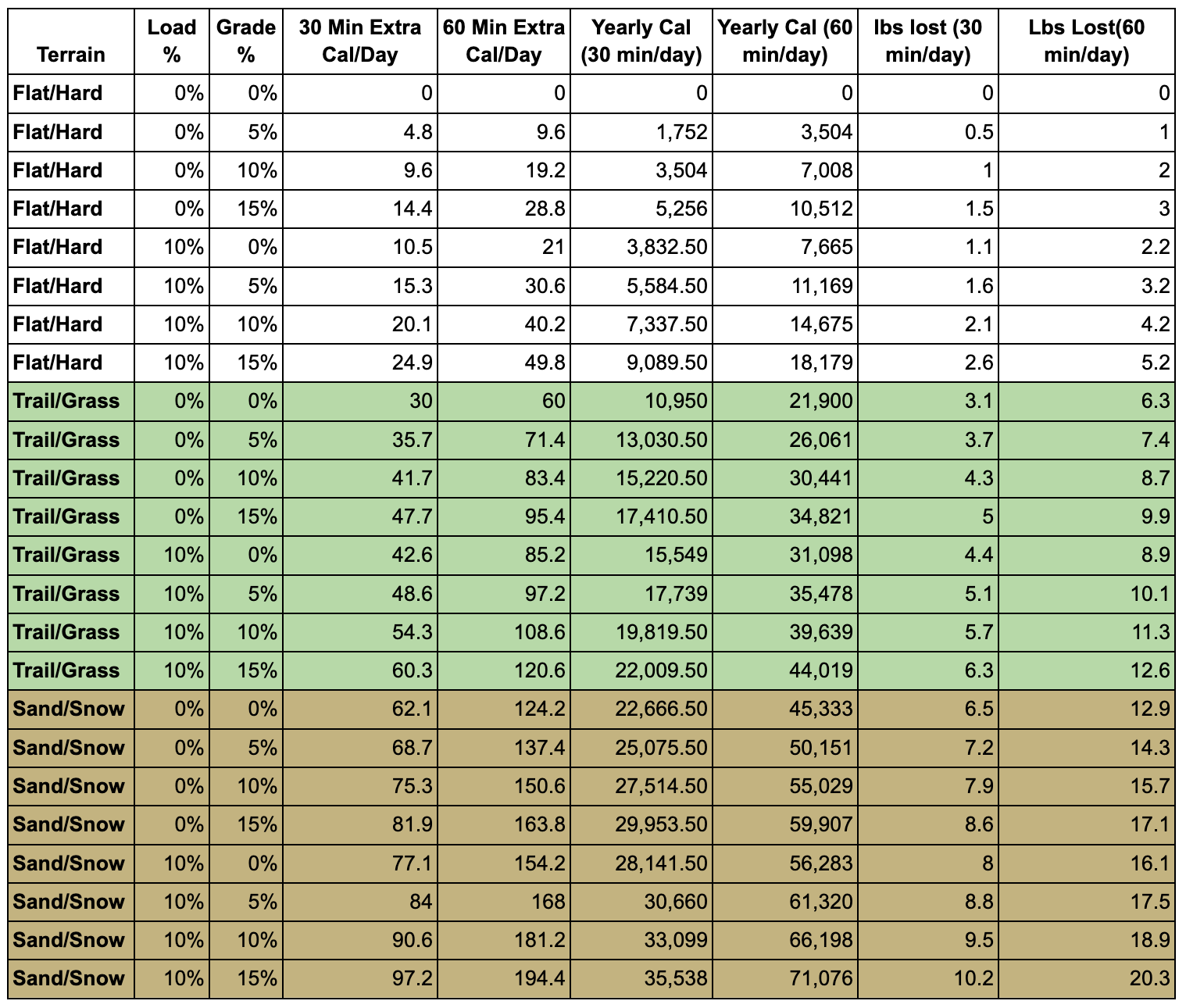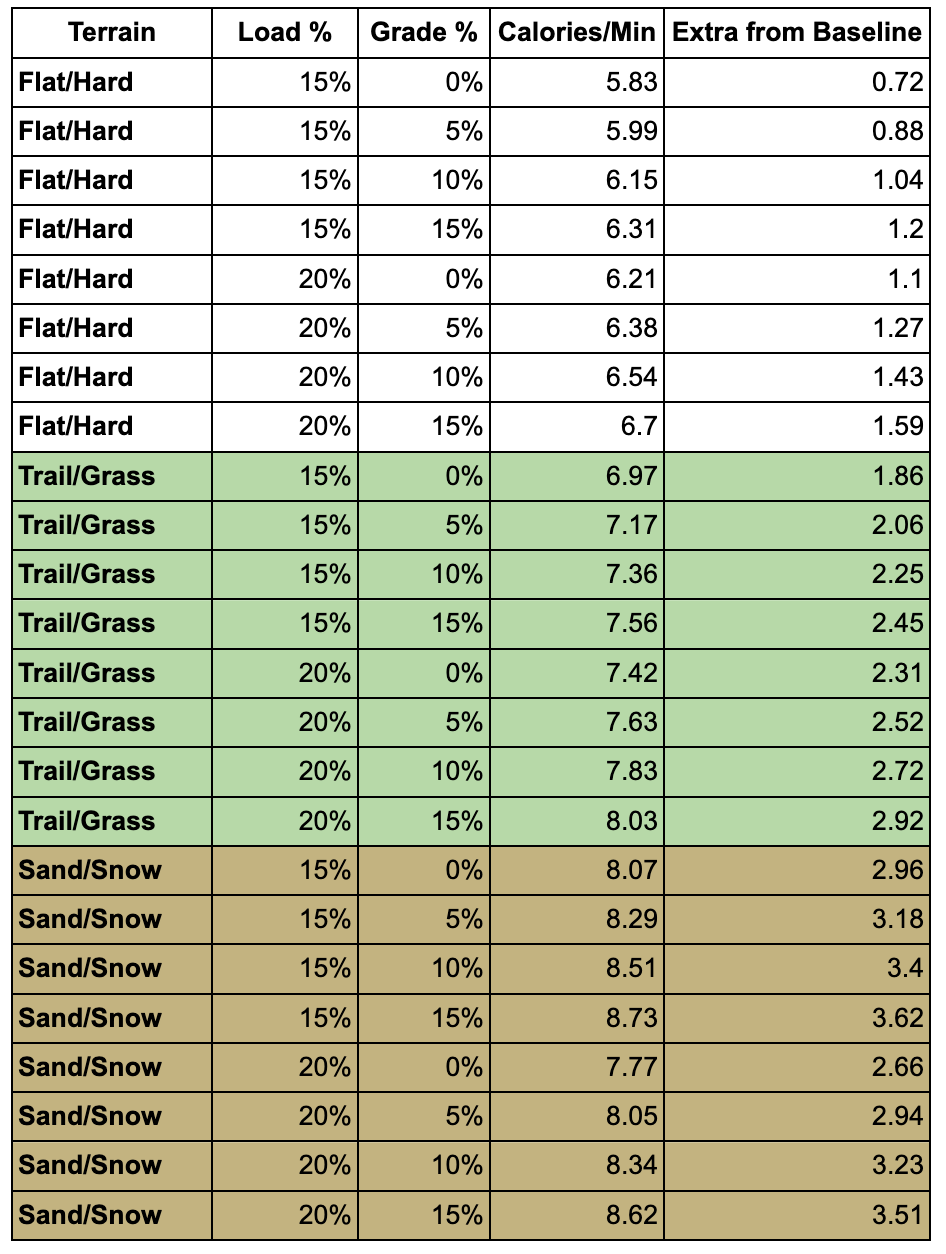NUCLEAR APPROACH TO WEIGHT VESTS
Discover how weighted walking significantly boosts calorie burn using the military-backed Pandolf Equation. Learn how weight vests, incline, and terrain amplify your fitness results far beyond standard estimates.
Do you want to burn even more calories?
In my last piece we dived into the question: does the weight vest burn more calories? I hate the fact that I have to write something that is so unequivocally logically obvious…yes it does. To think otherwise would be frankly pretty stupid.
The argument against vests was that it doesn’t burn that much. When the rubber meets the pavement we are talking 1 calorie a minute, sometimes less, sometimes more. I’m not going to get into the long term math here, but what seems like a small number, is actually a big number when we can agree to the fact that longer term commitments can lead to better results, but require consistency and the ability to put in the work.
If you are that person you are going to like the rest of this article; light vest work was just the beginning.
TLDR; Light vest work roughly about 5-10% body weight burns roughly 0.5-1 calorie per minute for most movement activities.
Now to the real talk: Pandolf equation.
The Pandolf Equation is a military-developed formula used to estimate energy expenditure during walking while carrying external load. It is one of the most widely cited models for predicting how much harder walking gets when you add weight and accounts for things like grade and different terrains.
E=1.5×W+2.0×(W+L)×(2WL)2+η×(W+L)×V2
This tends to look like some “Good Will Hunting” stuff but effectively it states that you burn more calories walking with more weight, as the grade increases, and as the terrain becomes more difficult (sand, snow, mud, etc.).
I never fully understood this equation until I thought back to a distant memory of a hike I did in Canmore in my early twenties. It is a vivid memory, not only because of the hike itself, but because of what I ate after and the 0 effect it had on my weight.
My wife and I scaled Lady Macdonald on one beautiful summer day. When word of mouth was king, this trail in the heart of the Canmore was said to be for beginners. I don’t know who the fuck thought that but it was essentially a 45% grade for the first hour and we bonked out and half way up. Went too hard at the beginning; Inexperience at its best. We slowly made our way to what we thought was the top, sat down and ate our packed lunch, and realized we still had a small scramble to the top to sit on a vantage point that was supposed to be worth it all. We said fuck that because we didn’t have enough food and we were extremely hungry already, thinking this was an easy hike. It was 2 hours to the near summit, with an insane grade, switch backs, and climbing up massive stones.
We headed down, which for anyone used to hiking, the way down isn’t necessarily easier with the eccentric load the whole way down..but it is faster. At completion I wouldn’t say we were completely dead, because we took it pretty easy after the bonking. It was hours of walking with packs filled with food and water, and tough terrain. I don’t think I’ve been hungry in my life outside of my extreme water cut for Powerlifting Nationals where I lost 30lbs in a week and needed to reconstitute weight before stepping on the platform…that is saying a lot trust me.
The reason why this story is important is because of what we did after. The legendary ‘La Poutine’ (now closed) was the first place we stopped because we wanted calories, we wanted salt, and we wanted it now. For those of you who don’t know of the legend, ‘La Pountine’ hosts every type of poutine you could think of with the house special being a Montreal-Style poutine mixed with cheese curds, fries, gravy, and smoked meats. All the calories.
Not only did I not gain a lb the whole trip, I felt absolutely amazing following the act of gluttony. I’ll never forget it. I outworked a bad diet!
This was before the age of all trails and constant monitoring of fitness wearable, so I don’t have the exact numbers, so this isn’t science at its best but it highlights a key point. I burnt a lot of calories and I ate a lot of calories.
Now what’s going on here? And more specifically how do we take this concept of external weight and put it on steroids for people that want to take science and math and talk about this tools in a way that fucks shit up and doesn’t deter people from doing more?
Well I’m glad you asked.
Let’s define terms here. Previously we used MET scores to estimate simple calories for walking under simple standards. The MET score system is great but falls apart when we try to introduce multipliers and super contextual variables. It’s more or less a guide to rank easy activities to harder activities and assign them a number for calorie expenditure estimations.
What’s the Difference Between MET Estimates and the Pandolf Equation?
MET Estimates (What Most People Use):
METs (Metabolic Equivalent of Task) are population averages of calorie burn, gathered from indirect calorimetry studies.
They tell you how much energy the average person burns at a given speed or activity, like walking or running—but they don’t automatically adjust for load, incline, or terrain.
METs are easy to use because they’re simple:
Calories/min=200(MET×3.5×bodyweight in kg)
Pandolf Equation (Load-Specific, Physics-Based Model):
The Pandolf equation was designed by the military to predict the actual energy cost of walking with external load (like vests, packs, or rucks).
It considers:
Bodyweight + Load
Speed squared (
V2)Terrain difficulty (flat, sand, snow, hills)
Incline/Grade
TL;DR:
METs = population averages for calorie burn.
Pandolf = physics-based formula for calorie burn with load, hills, or rough terrain.
Use METs for general fitness estimates.
Use Pandolf when you’re carrying weight or walking on incline.
Now let’s do some math.
Previously we looked at what was the extra calorie math for 10% extra load so I want to revisit that with the added use of Pandolf Equation accounting for grade, terrain, and both of them combined as multipliers. For sake of similar comparisons I used 3.5 mph walking as the constant here, so numbers will vary depending how slow or fast you choose to walk…but it’s walking, not running.
The following table:
The cool thing about this is previously we looked at small changes of 1 calorie per minute for running, but this was for running and it was much more reduced when we looked at walking at about 0.68 calories per minute extra. The Pandolf equation usually gives a lower calorie estimate than standard MET-based calculations because it’s designed to measure mechanical work and external load carriage, not total metabolic cost including inefficiencies. Generally speaking it’s about 25-30% difference, with the Pandolf consistently lower. I’m okay with this because lower means we have the chance for it to actually be much higher, but we have to work with what we’ve got, which is a common strategy for most evidence based people…for good or bad we die on that hill…well in this instance we are going to use that to use a lower estimation so that no one can claim that I’m trying to oversell the hype. To repeat. The Pandolf Equation is much lower in calorie expenditure estimations. Let’s continue.
What does this look like in a yearly context for both 30 minutes a day, 60 minutes a day, with both calories expended and weight loss in lbs.
The following table:
This is pretty interesting. We are talking double and triple the numbers from our previous experiment. Seems like weighted wear and other multipliers starts to make walking look pretty damn good.
Now let’s look at the nuclear plan. You aren’t average and you want to start to stick it to the people who think external weight and walking burns a measly 0.5-1 calorie a minute. This is where the real fun begins.
We are going to look at these same charts but with the 15% and 20% extra load respectively.
The following table:
Now we are cooking with oil. Remember that The Pandolf Equation is arguably lower, we are achieving numbers on par with running with a weight vest at the lower end with adding a vest plus increasing grade, and as much as 60% percent higher with 20% added load. That is only on flat/hard surfaces.
I am almost hesitant to start to push trail/grass and sand/snow just because of the nature of the fact not everyone can control for that, but if we dive into those categories we are talking SUBSTANTIALLY higher upwards of 3.51 calories a minute. That would be overselling it based on the fact we aren’t going to find that terrain in most people's situations. That being said, it’s there for you to see.
Let’s finally convert this chart into calories.
The following table:
The Bottom Line: Your Secret Weapon for Calorie Burn
I'll leave this here, but we aren't talking in small numbers anymore. I must also remind you that these figures are above and beyond what we would expend doing the same amount of time walking with 0% added weight. This doesn’t even account for the simple fact that increasing our time fighting gravity while walking is a weight loss tool in its own right.
So, if you're looking for a low-impact, highly effective way to significantly boost your calorie expenditure, the answer is clear:
Weighted walking is your secret weapon. It's not just about tiny increments; it's about harnessing the power of physics to amplify your efforts, leading to genuinely impactful results over time. Don't let anyone tell you that a weight vest only burns a "measly" 0.5-1 calorie a minute. The science, and my own experience, tell a very different, far more exciting story. Go put in the work, and watch the numbers add up.





